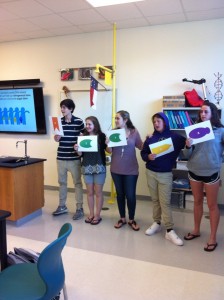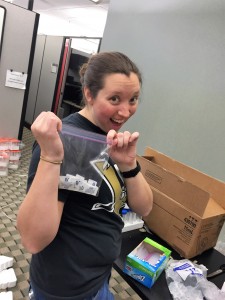Written by Julia DiFiore
Edited by Kelsey Gray and Amanda Raimer
On April 25, 2016 over 100 scientists from UNC Chapel Hill, Duke, NC State, NIEHS, UNC Charlotte, and Wake Forest traveled to over 200 North Carolina high school classrooms armed with DNA extraction kits and interactive lessons, sharing their enthusiasm for science with students across the state. Amazingly, work to make this trip possible began nearly 150 years ago with Johann Friedrich Miescher’s discovery of a molecule now called deoxyribonucleic acid, or DNA. DNA is the “genetic blueprint” for all life on Earth and explains the diverse shapes, colors, sizes, and behaviors of the living things we see around us. In 1953, 84 years after the discovery of DNA, research led by Rosalind Franklin, James Watson, and Francis Crick revealed the double helix structure of DNA and launched biology into a new era. Now scientists could make predictions about how genetic information is passed along through generations and about how cells use DNA . In the decades since, scientists have learned more about DNA every day. From the completion of the Human Genome Project in 2003 to recent breakthroughs in medical treatments using gene therapy, it remains clear that we still have a lot to discover about this incredible molecule.
North Carolina DNA Day was created to introduce high school students to how current genetics research impacts their lives. Every April, scientists visit high schools across the state of North Carolina to teach lessons related to current research and technology. While a major goal of DNA Day is to connect scientists and high school students, the program also aims to introduce students to possible careers in science that they may have never considered before. DNA Day also provides a valuable opportunity for scientists to engage with the community and share their research experience with a broad audience.

Students participate in an interactive lesson about DNA repair

DNA Day Ambassador Casey Schmidt helps pack supplies for DNA extractions before DNA Day
This year, students had the opportunity to learn about one of four different topics, including how DNA is used in forensic science to solve criminal cases, how antibiotics and vaccines affect our immune system, or how variations in our DNA can be used to customize medical treatments. The new module for 2016 allowed scientists to introduce students to the Nobel Prize-winning work related to repair of damaged DNA that was done in part by Dr. Aziz Sancar at UNC and Dr. Paul Modrich at Duke. Casey Schmidt, a fourth year graduate student at UNC Chapel Hill, had the opportunity to bring this module to Corinth Holders High School in Wendell, NC. She said the lesson helped students understand how common DNA damage is and the importance of properly repairing it. With prom rapidly approaching, some students had been tanning and the lesson took on a particular significance for them. Overall, Casey enjoyed showing students how the material they learn about in science classes is applicable to problems people face every day. She was also excited to challenge their beliefs about what a scientist looks likesince, “at their age, most of them think scientists are old guys with crazy hair that work in a basement. I like showing them that anyone can be a scientist and that working in a lab is actually a lot of fun.” Thanks to the hard work and passion of scientists across the state, many high school students were able to experience science in a new way and see it as something everyone can participate in, not just old guys with crazy hair.
